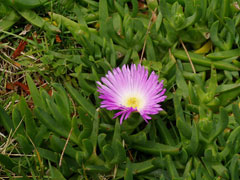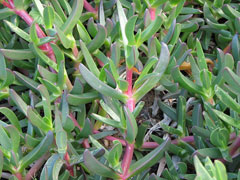 |
|
http://commons.wikimedia.org/wiki/User:Dlanglois |
 |
| http://commons.wikimedia.org/wiki/File:Carpobrotus_glaucescens_leaves.jpg |
Translate this page:
Summary
Physical Characteristics

 Carpobrotus glaucescens is an evergreen Perennial growing to 0.3 m (1ft) by 2 m (6ft 7in).
Carpobrotus glaucescens is an evergreen Perennial growing to 0.3 m (1ft) by 2 m (6ft 7in).
See above for USDA hardiness. It is hardy to UK zone 9. The species is hermaphrodite (has both male and female organs) and is pollinated by Insects.
Suitable for: light (sandy), medium (loamy) and heavy (clay) soils, prefers well-drained soil and can grow in nutritionally poor soil. Suitable pH: mildly acid, neutral and basic (mildly alkaline) soils. It can grow in semi-shade (light woodland) or no shade. It prefers dry or moist soil and can tolerate drought.
UK Hardiness Map
US Hardiness Map
Synonyms
Mesembryanthemum glaucescens Haw.
Plant Habitats
Cultivated Beds;
Edible Uses
Fruit - raw[193]. Considered a delicacy by the native people, the fruit has a soft, wet pulp with the flavour of salty strawberries or fresh, juicy figs[193]. The red to purple fruit is 20 - 30mm long[365]. Leaves - a salty flavour[193].
References More on Edible Uses
Medicinal Uses
Plants For A Future can not take any responsibility for any adverse effects from the use of plants. Always seek advice from a professional before using a plant medicinally.
The leaves are antiscorbutic[343]. The juice from the succulent leaves has been applied externally to relieve pain from insect bites[343].
References More on Medicinal Uses
The Bookshop: Edible Plant Books
Our Latest books on Perennial Plants For Food Forests and Permaculture Gardens in paperback or digital formats.

Edible Tropical Plants
Food Forest Plants for Hotter Conditions: 250+ Plants For Tropical Food Forests & Permaculture Gardens.
More

Edible Temperate Plants
Plants for Your Food Forest: 500 Plants for Temperate Food Forests & Permaculture Gardens.
More

More Books
PFAF have eight books available in paperback and digital formats. Browse the shop for more information.
Shop Now
Other Uses
Agroforestry Uses: Species in this genus have a vigorous, prostrate growth habit, producing a dense carpet of foliage and making a very effective ground cover. They can be planted in maritime areas, especially in Mediterranean climates, in order to prevent soil erosion in sandy soils, dunes and on banks[200, 208, 343]. The plant acts to stabilize sand dunes, even surviving burial by the sand[343]. It thus paves the way for other species to become established on the dunes[343]. The plant has very fleshy leaves and is moderately fire-resistant. It can be used in barrier plantings to prevent the spread of forest fires[200].
Special Uses
References More on Other Uses
Cultivation details
Carpobrotus glaucescens is a plant of low elevations, mainly in the subtropics but extending into the tropics[193]. It is not very cold-hardy, but can tolerate short periods with temperatures falling to around -2°c[200].
Succeeds in most relatively well-drained positions in either full sun or partial shade; though an open sunny position is best[343]. Found naturally in poor sandy soils and cliff faces[343]. Plants are tolerant of saline soils and maritime winds[343]. Established plants are drought tolerant[343].
References Carbon Farming Information and Carbon Sequestration Information
Temperature Converter
Type a value in the Celsius field to convert the value to Fahrenheit:
Fahrenheit:
The PFAF Bookshop
Plants For A Future have a number of books available in paperback and digital form. Book titles include Edible Plants, Edible Perennials, Edible Trees,Edible Shrubs, Woodland Gardening, and Temperate Food Forest Plants. Our new book is Food Forest Plants For Hotter Conditions (Tropical and Sub-Tropical).
Shop Now
Plant Propagation
Seed - surface sow in containers. Lower night-time temperatures are beneficial. The seed usually germinates in 7 - 10 days at 23°c[138]. When they are large enough to handle, prick the seedlings out into individual pots and grow them on until large enough to plant out.
Propagation is easiest by layering (rooting horizontal stem cuttings), as this is how the plant grows naturally[343]. These layers should be around 30 cm in length and planted leaving at least 5 cm of the plant above the sand or soil[343]. The plant can also be grown from cut pieces or division of large plants[343].
Other Names
If available other names are mentioned here
Native Range
AUSTRALASIA: Australia (New South Wales (east), Queensland (east), Victoria (east))
Weed Potential
Right plant wrong place. We are currently updating this section.
Please note that a plant may be invasive in one area but may not in your area so it's worth checking.
Conservation Status
IUCN Red List of Threatened Plants Status :

Growth: S = slow M = medium F = fast. Soil: L = light (sandy) M = medium H = heavy (clay). pH: A = acid N = neutral B = basic (alkaline). Shade: F = full shade S = semi-shade N = no shade. Moisture: D = dry M = Moist We = wet Wa = water.
Now available:
Food Forest Plants for Mediterranean Conditions
350+ Perennial Plants For Mediterranean and Drier Food Forests and Permaculture Gardens.
[Paperback and eBook]
This is the third in Plants For A Future's series of plant guides for food forests tailored to
specific climate zones. Following volumes on temperate and tropical ecosystems, this book focuses
on species suited to Mediterranean conditions—regions with hot, dry summers and cool, wet winters,
often facing the added challenge of climate change.
Read More
Expert comment
Author
(Haw.)Schwantes.
Botanical References
200265
Links / References
For a list of references used on this page please go here
Readers comment